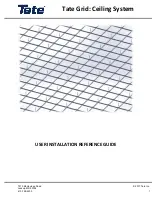
Use 3mm, 1/8” braided, very low stretch, net twine to
serve Pinger to head line. Cut two pieces of twine for
each Pinger about 450mm / 18” long. Insert twine into
end hole in Pinger casing. Push twine out of side hole.
Tie a figure 8 stop knot in the end of twine with
minimum tail. Pull figure 8 knot tight.
Pull figure 8 knot tight inside Pinger casing.
Clip tail if it protrudes outside of Pinger casing. This
offers a smooth non-fouling twine connection to
Pinger. Repeat twine attachment procedure on both
ends of Pinger.
Using a fid, pull twine through head line. Pull Pinger as
tight as possible to head line.
Lay a minimum of 6 rolling hitches around head line
while ensuring the end of the Pinger stays as tight to
the headline as possible. Pull rolling hitches as tight
as possible.
Using a fid, lead the twine tail through the headline
two or three times to seize the serving. Leave bitter
end of tail inside of head line to avoid fouling. Repeat
process on other end of Pinger.
It is critical to keep the head line as tight and as close
as possible to the Pinger casing. The head line will
stretch and will make the serving even tighter when
under load. When the net is stowed the head line will
relax and the serving will loosen. This why
it is critical to have a very tight Pinger attachment.
Overview:
Properly served Pingers will not foul nets or deck
gear. Pingers that come loose must be reattached
to avoid damage to nets, Pingers and deck gear. This
attachment method allows the use of net reels or net
pounds with minimum risk of net fouling.
Future Oceans is the world leader in the design and
manufacture of Pingers, which are used and trusted by
commercial fishermen all over the world.
If you have any questions about our products please
visit our website.
www.futureoceans.com
Pinger Attachment Instructions
Whales, Porpoises and Dolphins
avoid the net with Pingers deployed.
They pass the net unharmed and
fishing continues uninterupted and
your net remains intact.
Whales detect Pingers and avoid
the lines and traps, leaving your
valuable gear where it should be.
Bouy
Whale Pingers spaced every 50 meters / 150 feet / 25 fathoms,
Porpoise and Dolphin Pingers spaced every 100 meters / 300 feet / 50 fathoms
Whale Pingers spaced every 50 meters / 150 feet / 25 fathoms
Ocean Bottom
Main Bouy
Toogle
Pinger spacing
50 meters / 150 feet / 25 fathoms
Escape Area:
No Pingers placed 50 metres either side of opening
to allow foraging Porpoises and Dolphins to escape
unharmed.
Pinger spacing
50 meters / 150 feet / 25 fathoms
Gill Nets – Pinger Deployment
Line and Trap – Pinger Deployment
Ocean Bottom
Purse Seine – Pinger Deployment
Porpoise and Dolphin Pingers Deployed
Whale Pingers Deployed




















